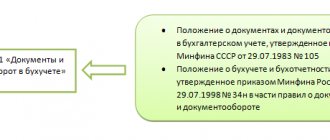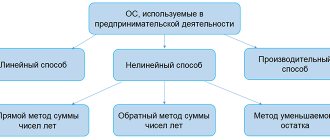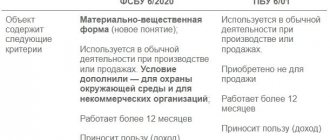Kontur.Accounting is a web service for small businesses!
Quick establishment of primary accounts, automatic tax calculation, online reporting, electronic document management, free updates and technical support.
Try it
Accounting is regulated by law. An accountant always has with him Federal Law No. 402-FZ “On Accounting” and 24 accounting regulations (PBU), which are considered federal standards. If an accountant has doubts about accounting, he first turns to PBU. In the article we will provide a reference book of PBU with a brief description.
What is PBU
PBU is the main regulatory document for accounting of a commercial enterprise. The provisions apply regardless of taxation system and business size. The PBU specifies the rules and requirements that a company’s accounting must comply with. Accounting regulations were approved by the Ministry of Finance of the Russian Federation.
The PBU reference book is needed to understand what each provision regulates and when it needs to be applied. It is not a fact that you apply all the provisions. You won’t need some of them, it all depends on the nature and size of the activity.
For reference: in the article we talk only about the PBUs that regulate accounting for commercial organizations and individual entrepreneurs. Accounting for non-profit and credit institutions is conducted differently and on the basis of other standards.
“Key” PBUs
There are 24 positions in total. But at the same time they are used very rarely. Let's look at the key PBUs that most companies use.
PBU 1/2008 “ Accounting policies of the organization ”
Based on these instructions, firms draw up accounting policies (AP). The Regulations contain instructions for the formation of the UP.
PBU 3/2006 “ Accounting for assets and liabilities, the value of which is expressed in foreign currency ”
PBU is used in foreign economic activity, when it is necessary to convert currency into rubles. Regulates methods for recognizing expenses and income in foreign currency and accounting for exchange rate differences.
PBU 4/1999 “ Accounting statements of an organization ”
The document contains information about reporting forms and the procedure for preparation. The Regulations introduce and explain the concepts of simplified, consolidated, liquidation and reorganization reporting.
PBU 5/2001 “ Accounting for inventories ”
Even the provision of services is difficult to imagine without taking into account raw materials and supplies. The document regulates everything related to inventories - from the procedure for forming their value to writing them off for production.
PBU 6/2001 “ Accounting for fixed assets ”
The regulations teach how to evaluate fixed assets, talk about methods of calculating depreciation, restoration and disposal. It also says how to enter data on fixed assets into reporting.
PBU 7/1998 “ Events after the reporting date ”
The document introduces the concept of an event after the reporting date. This is a significant transaction that was completed after the financial statements for the year were signed. For example, discovering an error in accounting.
PBU 9/1999 “ Income of the organization ” and PBU 10/99 “ Expenses of the organization ”
They regulate the procedure for accounting for the company’s income and expenses and their disclosure in reporting. The classification of income and expenses is approved - into “other” and “from core activities”.
Keep your accounting in the cloud service Kontur.Accounting: it fully complies with PBU and the Federal Law “On Accounting”.
PBU 14/2007 “ Accounting for intangible assets ”
PBU indicates the procedure for accounting, evaluation, depreciation and write-off of intangible accounting objects. A patent, industrial design, trademark or name, strains are an incomplete list of intangible assets.
PBU 15/2008 “ Accounting for expenses on loans and credits ”
Applicable to all organizations that receive loans. PBU determines the procedure for calculating and recognizing expenses on loans received.
PBU 18/2002 “ Accounting for income tax calculations ”
Used by companies on OSNO. The document establishes the procedure for generating income tax. Introduces concepts that are difficult for an accountant, such as permanent and temporary differences.
PBU 9/99
Approved by Order of the Ministry of Finance of the Russian Federation dated May 6, 1999 No. 32n
I. General provisions
1. These Regulations establish the rules for the formation in accounting of information on the income of commercial organizations (except for credit and insurance organizations) that are legal entities under the legislation of the Russian Federation.
In relation to this Regulation, non-profit organizations (except for state (municipal) institutions) recognize income from business and other activities (paragraph as amended, put into effect on March 3, 2000 by Order of the Ministry of Finance of Russia dated December 30, 1999 No. 107n; as amended, introduced in effective from January 1, 2011 by Order of the Ministry of Finance of Russia dated October 25, 2010 No. 132n - see previous edition).
2. An organization’s income is recognized as an increase in economic benefits as a result of the receipt of assets (cash, other property) and (or) repayment of liabilities, leading to an increase in the capital of this organization, with the exception of contributions from participants (owners of property).
3. For the purposes of these Regulations, receipts from other legal entities and individuals are not recognized as income of the organization:
amounts of value added tax, excise taxes, sales tax, export duties and other similar mandatory payments;
under commission agreements, agency and other similar agreements in favor of the principal, principal, etc.;
in advance payment for products, goods, works, services;
advances in payment for products, goods, works, services;
deposit;
as collateral, if the agreement provides for the transfer of the pledged property to the pledgee;
in repayment of a loan granted to the borrower.
4. The income of the organization, depending on its nature, the conditions for receiving it and the areas of activity of the organization, are divided into:
a) income from ordinary activities;
b) other income (subparagraph as amended, put into effect starting with the annual financial statements for 2006 by Order of the Ministry of Finance of Russia dated September 18, 2006 No. 116n - see the previous edition);
c) subparagraph was excluded, starting from the annual financial statements for 2006, by Order of the Ministry of Finance of Russia dated September 18, 2006 No. 116n - see the previous edition.
For the purposes of these Regulations, income other than income from ordinary activities is considered other income (paragraph as amended, put into effect starting with the annual financial statements for 2006 by Order of the Ministry of Finance of Russia dated September 18, 2006 No. 116n - see previous edition) .
For accounting purposes, the organization independently recognizes receipts as income from ordinary activities or other income based on the requirements of these Regulations, the nature of its activities, the type of income and the conditions for their receipt.
II. Income from ordinary activities
5. Income from ordinary activities is revenue from the sale of products and goods, receipts associated with the performance of work, provision of services (hereinafter referred to as revenue).
In organizations whose subject of activity is the provision for a fee for temporary use (temporary possession and use) of their assets under a lease agreement, revenue is considered to be receipts the receipt of which is associated with this activity (rent).
In organizations whose subject of activity is the provision for a fee of rights arising from patents for inventions, industrial designs and other types of intellectual property, revenue is considered to be receipts the receipt of which is associated with this activity (license payments (including royalties) for the use of intellectual property).
In organizations whose subject of activity is participation in the authorized capital of other organizations, revenue is considered to be receipts of which are associated with this activity.
Income received by an organization from provision for a fee for temporary use (temporary possession and use) of its assets, rights arising from patents for inventions, industrial designs and other types of intellectual property, and from participation in the authorized capital of other organizations, when this is not the subject of activities of the organization, relate to other income (paragraph as amended, put into effect starting with the annual financial statements for 2006 by Order of the Ministry of Finance of Russia dated September 18, 2006 No. 116n - see the previous edition).
6. Revenue is accepted for accounting in an amount calculated in monetary terms equal to the amount of receipt of cash and other property and (or) the amount of accounts receivable (taking into account the provisions of paragraph 3 of these Regulations).
If the amount of receipt covers only part of the revenue, then the revenue accepted for accounting is determined as the sum of receipt and receivables (in the part not covered by receipt).
6.1. The amount of receipts and (or) receivables is determined based on the price established by the agreement between the organization and the buyer (customer) or user of the organization’s assets. If the price is not provided for in the contract and cannot be established based on the terms of the contract, then to determine the amount of receipts and (or) receivables, the price at which, in comparable circumstances, the organization usually determines revenue in relation to similar products (goods, works, services) is accepted. or providing for temporary use (temporary possession and use) of similar assets.
6.2. When selling products and goods, performing work, providing services on the terms of a commercial loan provided in the form of deferred and installment payment, the proceeds are accepted for accounting in the full amount of receivables.
6.3. The amount of receipts and (or) receivables under contracts providing for the fulfillment of obligations (payment) in non-monetary means is accepted for accounting at the cost of goods (valuables) received or to be received by the organization. The cost of goods (valuables) received or to be received by an organization is established based on the price at which, in comparable circumstances, the organization usually determines the cost of similar goods (valuables).
If it is impossible to determine the value of goods (valuables) received by the organization, the amount of receipts and (or) receivables is determined by the value of the products (goods) transferred or to be transferred by the organization. The cost of products (goods) transferred or to be transferred by an organization is established based on the price at which, in comparable circumstances, the organization usually determines revenue in relation to similar products (goods).
6.4. In the event of a change in the obligation under the contract, the initial amount of receipts and (or) receivables is adjusted based on the value of the asset to be received by the organization. The value of an asset to be received by an organization is determined based on the price at which, in comparable circumstances, the organization usually determines the value of similar assets.
6.5. The amount of receipts and (or) receivables is determined taking into account all discounts (mark-ups) provided to the organization in accordance with the agreement.
6.6. The item has been excluded from the financial statements since 2007 by Order of the Ministry of Finance of Russia dated November 27, 2006 No. 156n. – See previous edition.
6.7. When provisions for doubtful debts are formed in accordance with the accounting rules, the amount of revenue does not change.
III. Other supply
7. Other income is (paragraph as amended, put into effect starting with the annual financial statements for 2006 by Order of the Ministry of Finance of Russia dated September 18, 2006 No. 116n - see the previous edition):
receipts associated with the provision for a fee for temporary use (temporary possession and use) of the organization’s assets (taking into account the provisions of paragraph 5 of these Regulations) (paragraph supplemented, starting with the financial statements of 2001, by Order of the Ministry of Finance of Russia dated March 30, 2001 No. 27n, – see previous edition);
receipts related to the provision for a fee of rights arising from patents for inventions, industrial designs and other types of intellectual property (taking into account the provisions of paragraph 5 of these Regulations) (paragraph supplemented, starting with the financial statements of 2001, by Order of the Ministry of Finance of Russia dated March 30, 2001 No. 27n, – see previous edition);
receipts associated with participation in the authorized capitals of other organizations (including interest and other income on securities) (taking into account the provisions of paragraph 5 of these Regulations) (paragraph supplemented, starting with the financial statements of 2001, by Order of the Ministry of Finance of Russia dated March 30, 2001 No. 27n , – see previous edition);
profit received by the organization as a result of joint activities (under a simple partnership agreement);
proceeds from the sale of fixed assets and other assets other than cash (except foreign currency), products, goods;
interest received for the provision of an organization's funds for use, as well as interest for the bank's use of funds held in the organization's account with this bank.
8. The paragraph has been excluded starting from the annual financial statements for 2006 by Order of the Ministry of Finance of Russia dated September 18, 2006 No. 116n - see the previous edition:
fines, penalties, penalties for violation of contract terms;
assets received free of charge, including under a gift agreement;
proceeds to compensate for losses caused to the organization;
profit of previous years identified in the reporting year;
amounts of accounts payable and depositors for which the statute of limitations has expired;
exchange differences;
the amount of revaluation of assets (paragraph as amended, put into effect starting from the financial statements of 2001 by Order of the Ministry of Finance of Russia dated March 30, 2001 No. 27n - see the previous edition);
other income (paragraph as amended, put into effect starting with the annual financial statements for 2006 by Order of the Ministry of Finance of Russia dated September 18, 2006 No. 116n - see the previous edition).
9. Other income also includes income arising as a consequence of emergency circumstances of economic activity (natural disaster, fire, accident, nationalization, etc.): the cost of material assets remaining from the write-off of assets unsuitable for restoration and further use, etc. (clause as amended, put into effect starting with the annual financial statements for 2006 by Order of the Ministry of Finance of Russia dated September 18, 2006 No. 116n - see the previous edition).
10. For accounting purposes, the amount of other income is determined in the following order:
10.1. The amount of proceeds from the sale of fixed assets and other assets other than cash (except foreign currency), products, goods, as well as the amount of interest received for providing the organization’s funds for use, and income from participation in the authorized capitals of other organizations (when is not the subject of the organization’s activities) is determined in a manner similar to that provided for in paragraph 6 of these Regulations.
10.2. Fines, penalties, penalties for violations of contract terms, as well as compensation for losses caused to the organization are accepted for accounting in amounts awarded by the court or recognized by the debtor.
10.3. Assets received free of charge are accepted for accounting at market value. The market value of assets received free of charge is determined by the organization on the basis of prices in force on the date of their acceptance for accounting for this or a similar type of asset. Data on prices valid on the date of acceptance for accounting must be confirmed by documents or through an examination.
10.4. Accounts payable for which the statute of limitations has expired are included in the organization's income in the amount in which this debt was reflected in the organization's accounting records.
10.5. The amounts of revaluation of assets are determined in accordance with the rules established for the revaluation of assets.
10.6. Other income is accepted for accounting in actual amounts.
11. Other receipts are subject to credit to the organization’s profit and loss account, except in cases where the accounting rules establish a different procedure.
IV. Revenue recognition
12. Revenue is recognized in accounting if the following conditions are met:
a) the organization has the right to receive this revenue arising from a specific agreement or confirmed in another appropriate manner;
b) the amount of revenue can be determined;
c) there is confidence that as a result of a particular transaction there will be an increase in the economic benefits of the organization. Confidence that a particular transaction will result in an increase in the economic benefits of the organization exists when the organization received an asset in payment or there is no uncertainty regarding the receipt of the asset;
d) the right of ownership (possession, use and disposal) of the product (goods) has passed from the organization to the buyer or the work has been accepted by the customer (service provided);
e) the expenses that have been incurred or will be incurred in connection with this operation can be determined.
If at least one of the above conditions is not met in relation to cash and other assets received by the organization as payment, then the organization’s accounting records recognize accounts payable, not revenue.
To recognize in accounting revenues from the provision for a fee for temporary use (temporary possession and use) of one’s assets, rights arising from patents for inventions, industrial designs and other types of intellectual property and from participation in the authorized capital of other organizations, must be simultaneously observed the conditions defined in subparagraphs “a)”, “b)” and “c)” of this paragraph.
Organizations that have the right to use simplified accounting methods, including simplified accounting (financial) statements, may recognize revenue as funds are received from buyers (customers) subject to the conditions specified in subparagraphs “a”, “b”, “c” and “d” of this paragraph.
(The paragraph was additionally included starting from the annual financial statements for 2010 by Order of the Ministry of Finance of Russia dated November 8, 2010 No. 144n; as amended, put into effect starting from the annual financial statements for 2012 by Order of the Ministry of Finance of Russia dated April 27, 2012 No. 55n; as amended , put into effect on May 17, 2015 by Order of the Ministry of Finance of Russia dated April 6, 2015 No. 57n - See previous edition.)
13. An organization may recognize in accounting revenue from the performance of work, provision of services, sale of products with a long manufacturing cycle as the work, service, product is ready or upon completion of the work, provision of service, or manufacture of products in general.
Revenue from performing specific work, providing a specific service, or selling a specific product is recognized in accounting as it is ready, if it is possible to determine the readiness of the work, service, or product.
In relation to work, provision of services, and manufacture of products that are different in nature and conditions, an organization may simultaneously apply different methods of revenue recognition provided for in this paragraph in one reporting period.
14. If the amount of revenue from the sale of products, performance of work, provision of services cannot be determined, then it is accepted for accounting in the amount of expenses recognized in accounting for the manufacture of these products, performance of this work, provision of this service, which will subsequently be reimbursed to the organization .
15. Rent and license payments for the use of intellectual property (when this is not the subject of the organization’s activities) are recognized in accounting based on the assumption of temporary certainty of the facts of economic activity and the terms of the relevant agreement.
Rent and license payments for the use of intellectual property (when this is not the subject of the organization’s activities) are recognized in accounting in a manner similar to that provided for in paragraph 12 of these Regulations.
16. Other income is recognized in accounting in the following order:
proceeds from the sale of fixed assets and other assets other than cash (except foreign currency), products, goods, as well as interest received for the provision of the organization’s funds for use, and income from participation in the authorized capital of other organizations (when this is not subject of the organization’s activities) - in a manner similar to that provided for in paragraph 12 of these Regulations. In this case, for accounting purposes, interest is accrued for each expired reporting period in accordance with the terms of the agreement;
fines, penalties, penalties for violation of the terms of contracts, as well as compensation for losses caused to the organization - in the reporting period in which the court made a decision to collect them, or they were recognized as a debtor;
the amount of accounts payable and depository debt for which the limitation period has expired - in the reporting period in which the limitation period has expired;
the amount of revaluation of assets - in the reporting period to which the date as of which the revaluation was made;
other receipts - as they are formed (identified).
V. Disclosure of information in financial statements
17. As part of the information on the accounting policies of the organization in the financial statements, at least the following information is subject to disclosure:
a) on the procedure for recognizing the organization’s revenue;
b) on the method of determining the readiness of work, services, products, revenue from the implementation, provision, sale of which is recognized as readiness.
18. In the financial results statement, the organization’s income for the reporting period is reflected with a division into revenue and other income.
- See previous edition.)
18.1. Revenue, other income (revenue from the sale of products (goods), revenue from the performance of work (provision of services), etc.), amounting to five or more percent of the organization’s total income for the reporting period, are shown for each type separately (item as amended, put into effect starting with the annual financial statements for 2006 by Order of the Ministry of Finance of Russia dated September 18, 2006 No. 116n - see the previous edition).
18.2. Other income may be shown on the income statement less expenses related to that income when:
- See previous edition.)
a) the relevant accounting rules provide for or do not prohibit such recognition of income;
b) income and related expenses arising as a result of the same or similar fact of economic activity (for example, the provision of temporary use (temporary possession and use) of its assets) are not significant for characterizing the financial position of the organization.
19. With respect to revenue received as a result of the execution of contracts providing for the fulfillment of obligations (payment) in non-monetary means, at least the following information is subject to disclosure:
a) the total number of organizations with which the specified contracts are carried out, indicating the organizations that account for the bulk of such revenue;
b) the share of revenue received under these agreements with related organizations;
c) a method for determining the cost of products (goods) transferred by the organization.
20. Other income of the organization for the reporting period, which, in accordance with the accounting rules, are not credited to the profit and loss account, are subject to disclosure in the financial statements separately.
21. The structure of accounting should ensure the possibility of disclosing information about the organization’s income in the context of current, investment and financial activities.
22. In cases where the disclosure of information in the notes to the balance sheet and the financial results statement to the extent provided for by these Regulations will lead or may lead to losses of an economic nature and (or) damage to the business reputation of the organization and (or) its counterparties, and ( or) related parties, the organization may disclose information in the notes to the balance sheet and income statement to a limited extent, without disclosing the information that causes the specified losses and (or) damage.
(The paragraph was additionally included from February 27, 2022 by Order of the Ministry of Finance of Russia dated November 27, 2022 No. 287n.)
“Situational” PBUs
In the reference book, PBUs are called situational, since they are used much less frequently than the previous ones. These standards regulate specific accounting transactions. These provisions include:
- “Accounting for construction contracts”;
- “Information about related parties”;
- “Accounting for state aid”;
- “Information on discontinued activities”;
- “Accounting for R&D expenses”;
- “Accounting for financial investments”;
- “Information on participation in joint activities”;
- “Change in estimated values”;
- “Correction of errors in accounting and reporting”;
- “Cash Flow Statement.”
To maintain error-free accounting, use the cloud service Kontur.Accounting. The regulatory framework of the service fully complies with the Federal Law “On Accounting” and PBU. A free 30-day trial is provided to all new users.
GLAVBUKH-INFO
| All pages |
Page 1 of 2
Registered with the Ministry of Justice of the Russian Federation on May 31, 1999 N 1791
MINISTRY OF FINANCE OF THE RUSSIAN FEDERATION
ORDER dated May 6, 1999 N 32n
ON APPROVAL OF ACCOUNTING REGULATIONS “ORGANIZATION’S INCOME” PBU 9/99
(as amended by Orders of the Ministry of Finance of the Russian Federation dated December 30, 1999 N 107n, dated March 30, 2001 N 27n, dated September 18, 2006 N 116n, dated November 27, 2006 N 156n)
In pursuance of the Program for reforming accounting in accordance with international financial reporting standards, approved by Decree of the Government of the Russian Federation of March 6, 1998 N 283, I order: 1. Approve the attached Accounting Regulations “Income of the organization” PBU 9/99. 2. Enter into force this Order from January 1, 2000.
Minister of Finance of the Russian Federation M. ZADORNOV
Approved by Order of the Ministry of Finance of the Russian Federation dated May 6, 1999 N 32n
ACCOUNTING REGULATIONS “ORGANIZATION’S INCOME” PBU 9/99
(as amended by Orders of the Ministry of Finance of the Russian Federation dated December 30, 1999 N 107n, dated March 30, 2001 N 27n, dated September 18, 2006 N 116n, dated November 27, 2006 N 156n)
I. General provisions
1. These Regulations establish the rules for the formation in accounting of information on the income of commercial organizations (except for credit and insurance organizations) that are legal entities under the legislation of the Russian Federation. In relation to these Regulations, non-profit organizations (except for budgetary institutions) recognize income from business and other activities. (as amended by Order of the Ministry of Finance of the Russian Federation dated December 30, 1999 N 107n) 2. An organization’s income is recognized as an increase in economic benefits as a result of the receipt of assets (cash, other property) and (or) repayment of liabilities, leading to an increase in the capital of this organization, with the exception of deposits participants (property owners). 3. For the purposes of these Regulations, receipts from other legal entities and individuals are not recognized as income of the organization: amounts of value added tax, excise taxes, sales tax, export duties and other similar mandatory payments; under commission agreements, agency and other similar agreements in favor of the principal, principal, etc.; in advance payment for products, goods, works, services; advances in payment for products, goods, works, services; deposit; as collateral, if the agreement provides for the transfer of the pledged property to the pledgee; in repayment of a loan granted to the borrower. 4. The income of the organization, depending on its nature, conditions for receipt and areas of activity of the organization, is divided into: a) income from ordinary activities; b) other income; (as amended by Order of the Ministry of Finance of the Russian Federation dated September 18, 2006 N 116n) c) excluded. — Order of the Ministry of Finance of the Russian Federation dated September 18, 2006 N 116n. For the purposes of these Regulations, income other than income from ordinary activities is considered other income. (as amended by Order of the Ministry of Finance of the Russian Federation dated September 18, 2006 N 116n) For accounting purposes, the organization independently recognizes receipts as income from ordinary activities or other income based on the requirements of these Regulations, the nature of its activities, the type of income and the conditions for their receipt.
II. Income from ordinary activities
5. Income from ordinary activities is revenue from the sale of products and goods, receipts associated with the performance of work, provision of services (hereinafter referred to as revenue). In organizations whose subject of activity is the provision for a fee for temporary use (temporary possession and use) of their assets under a lease agreement, revenue is considered to be receipts the receipt of which is associated with this activity (rent). In organizations whose subject of activity is the provision for a fee of rights arising from patents for inventions, industrial designs and other types of intellectual property, revenue is considered to be receipts the receipt of which is associated with this activity (license payments (including royalties) for the use of intellectual property). In organizations whose subject of activity is participation in the authorized capital of other organizations, revenue is considered to be receipts of which are associated with this activity. Income received by an organization from provision for a fee for temporary use (temporary possession and use) of its assets, rights arising from patents for inventions, industrial designs and other types of intellectual property, and from participation in the authorized capital of other organizations, when this is not the subject of activities of the organization are classified as other income. (as amended by Order of the Ministry of Finance of the Russian Federation dated September 18, 2006 N 116n) 6. Revenue is accepted for accounting in an amount calculated in monetary terms equal to the amount of receipt of cash and other property and (or) the amount of accounts receivable (taking into account the provisions of paragraph 3 of this Regulation). If the amount of receipt covers only part of the revenue, then the revenue accepted for accounting is determined as the sum of receipt and receivables (in the part not covered by receipt). 6.1. The amount of receipts and (or) receivables is determined based on the price established by the agreement between the organization and the buyer (customer) or user of the organization’s assets. If the price is not provided for in the contract and cannot be established based on the terms of the contract, then to determine the amount of receipts and (or) receivables, the price at which, in comparable circumstances, the organization usually determines revenue in relation to similar products (goods, works, services) is accepted. or providing for temporary use (temporary possession and use) of similar assets. 6.2. When selling products and goods, performing work, providing services on the terms of a commercial loan provided in the form of deferred and installment payment, the proceeds are accepted for accounting in the full amount of receivables. 6.3. The amount of receipts and (or) receivables under contracts providing for the fulfillment of obligations (payment) not in cash is accepted for accounting at the cost of goods (valuables) received or to be received by the organization. The cost of goods (valuables) received or to be received by an organization is established based on the price at which, in comparable circumstances, the organization usually determines the cost of similar goods (valuables). If it is impossible to determine the cost of goods (valuables) received by the organization, the amount of receipts and (or) receivables is determined by the value of the products (goods) transferred or to be transferred by the organization. The cost of products (goods) transferred or to be transferred by the organization is established based on the price at which, in comparable circumstances, the organization usually determines revenue in relation to similar products (goods). 6.4. In the event of a change in the obligation under the contract, the initial amount of receipts and (or) receivables is adjusted based on the value of the asset to be received by the organization. The value of the asset to be received by the organization is determined based on the price at which, in comparable circumstances, the organization usually determines the value of similar assets. 6.5. The amount of receipts and (or) receivables is determined taking into account all discounts (mark-ups) provided to the organization in accordance with the agreement. 6.6. Excluded. — Order of the Ministry of Finance of the Russian Federation dated November 27, 2006 N 156n. 6.7. When provisions for doubtful debts are formed in accordance with the accounting rules, the amount of revenue does not change.
Previous — Next >>
| < Previous | Next > |







